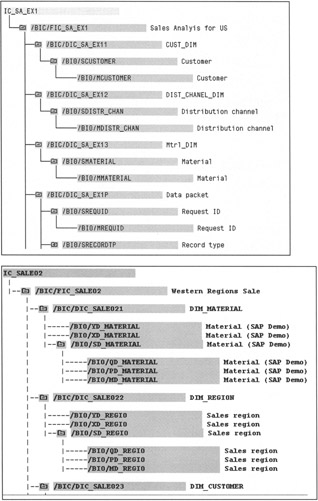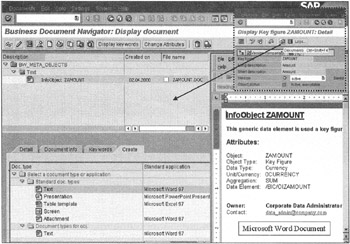SAP BW 2.0B Architecture
This release has several architectural changes to overcome InfoCube management. Following are only a few topics that have the most significant impact on SAP BW architecture.
The ROLAP Implementation-Star Schema Model
In its earlier versions, the star schema and its dimension tables, associated with a fact table, were connected to master data via SID tables. To optimize the slowly changing dimensional implementation in the SAP BW 2.0 OLAP model, SAP has changed its master data management architecture to separate time-independent and time-dependent master attributes. This separation of time-dependent data is represented in the star schema, which now has two SID tables associated with master data characteristics. An example of schemas in SAP BW 1.2B and 2.0A is shown in Figure D-1 as well as on the accompanying CD. You can list schemas using the LISTSCHEMA transaction. A Lotus ScreenCam movie on the accompanying CD shows how to list schema models in SAP BW 2.0A for a Basic InfoCube, an ODS object, and the MultiCube using the LISTSCHEMA transaction.

Figure D-1: InfoCube Schemas in SAP BW 1.2B, on the Top, and BW 2.0A, on the Bottom. Notice How the New Star Schema Accounts for Several New SID Tables, Where Each Dimension Characteristic Has Time-Dependent Master Data.
| Note | Prior to the BW 2.0A release, InfoObject names were limited to a maximum of 32 characters. Now you can have an InfoObject name with up to 60 characters. |
InfoSources and Data Sources in SAP BW
In SAP BW 2.0, the traditional InfoSource has been divided into two entities: the InfoSource and the DataSource. The reason for this split is to make metadata management simpler. For example, in SAP BW 1.2B, the InfoSources were very specific to individual Source OLTP systems, and that required installation, field mappings, and management of InfoObjects in both places: SAP R/3 OLTP and SAP BW. This situation gets complicated when you have multiple SAP R/3 OLTP instances for SAP BW. When you update metadata in SAP BW from the source system, the SAP R/3 that gets connected first wants to send metadata to SAP BW. This may cause problems if some source systems have different InfoObject definitions than the one that sent the metadata to SAP BW.
In SAP BW 2.0, InfoSources on OLTP are called DataSources. The metadata is simply replicated from the source instance to SAP BW, where necessary mapping and transformation takes place instead of in an OLTP instance. This method is simple and has very little impact on the SAP R/3 OLTP instance.
The Administrator Workbench
The SAP BW user interface has gone through several major changes in the last 12 months. The SAP BW 1.2B Administrator Workbench is shown in Figure D-2.

Figure D-2: Administrator Workbench in SAP BW 1.2B. The InfoCubes Tabstrip Lists all Available InfoCubes in a Tree Format Under the InfoCubes Tree Node.
In SAP BW 1.2B, under the InfoCubes tree node, you are able to create and manage an InfoArea or an InfoCube but not ODS. The ODS is generated automatically when you select tRFC with ODS transfer method, as shown in Figure 9-8, when defining transfer rules for the communication structure.
The Administrator Workbench in SAP BW 2.0A has changed significantly. Instead of SAP BW data object tabstrips on the top, now you have to select a task from the Goto drop-down menu and select an activity and the data object to from another list box, as shown in Figure D-3.

Figure D-3: Administrator Workbench in SAP BW 2.0A and SAP BW 2.0B.
Notice that the Administrator Workbench for SAP BW 2.0A looks somewhat different than its earlier version in SAP BW 1.2B. In SAP BW 2.0A, you still have the InfoCube tree node on the left, the InfoAreas, and the generated InfoCubes. In SAP BW 2.0A, ODS management is not fully integrated in the Administrator Workbench, as discussed in Chapter 17. The philosophy behind Administrator Workbench design was to present information objects in a tree fashion that makes it easier to navigate data objects and exploit drag-and-drop capabilities while modeling information objects.
In SAP BW 2.0B, the Administrator Workbench has gone through significant changes, as shown in Figure D-3. The most significant change is that there is no InfoCube tree as in SAP BW 1.2B and SP BW 2.0A. Instead, you see a new Data targets object, as shown in Figure D-3. The reason for this change is the fact that starting from SAP BW 2.0B, there are two types of data targets, InfoCubes and ODS objects. Notice that now when you select an InfoArea and right-click, the create object context menu lists two options-Create InfoCube and Create ODS object. Remember that the ODS object you create here is very different than what it was in SAP BW 1.2A, as discussed in Chapter 17.
Overall, the new Administrator Workbench is much easier to work with, especially when creating new InfoCubes or ODS objects because you can simply drag and drop objects from source to target instead of switching the screens.
Another significant feature in SAP BW 2.0B Administrator Workbench is that when you define a new InfoCube or copy an existing InfoCube, all relevant transfer rules, dimension assignments, update rules, as well as defined queries in the source data object are also propagated to the new data object. This feature alone will save hours of developers' time in SAP BW data object maintenance.
Within a year, SAP BW has gone through significant architectural changes that change the user interface. When installing SAP BW 2.0B GA or future versions, make sure that your Basis team applies the latest OSS notes.
The Operational Data Store (ODS)
The ODS implementation is another major architectural change in the SAP BW 2.0 architecture. The ODS architecture has changed the data warehouse design philosophy in 2.0; now you need to model objects differently than when you have only InfoCubes. Chapter 17 is dedicated to the ODS subject.
Business Document Services (BDS)
Most data warehouses are very much database- and data-centric and not much integrated with the business processes. On the average, about 80 percent of business information needs are based on unstructured documents. Documenting business processes and metadata associated with the information objects is key to making effective business decisions. These documents may come in any shape, size, or type and range from a simple text note from a customer to a project proposal for salespeople in Microsoft Word, a marketing PowerPoint presentation, or simply a fax image. In SAP BW 2.0, SAP provides a new concept to manage documents in the data warehouse using Business Document Services (BDS). The BDS consists of an easy-to-integrate document management component in the R/3 Basis System. This powerful Basis technology extends the data warehouse scope into the knowledge and document management boundary. You can link documents with InfoCatalog, InfoSource, InfoObjects, InfoCubes, Reports, Queries, or even calculated key figures in a query or report. Moreover, you can save InfoCube star schema data models and user guides in BDS to manage the SAP BW data warehouse development process and its implementation.
For example, say you want to document metadata for a key figure ZAMOUNT that you created earlier and used in the queries in Chapter 11. Often, end users want to know what this amount means or how it is computed in the queries. You can attach a document in Microsoft Word or any text editor and associate with the ZAMOUNT key figure, as shown in Figure D-4.

Figure D-4: The BDS Document Management Environment. Assigning a Document to Key Figure ZAMOUNT.
To assign a new document to ZAMOUNT key figure, edit the InfoObject and launch BDS navigator by clicking on the Document icon ![]() as shown in the top right of Figure D-4-Edit Key figure window marked with dotted lines. The BDS navigator allows you to select a wide array of document types to import in the BDS repository. In this example, you select a text document of Microsoft Word type, copy the document content in the window on the right to attach to ZAMOUNT key figure, and import it in the BDS. These documents are then available to end users through the Business Document Navigator, or by the Shift+F8 or Document commands when available.
as shown in the top right of Figure D-4-Edit Key figure window marked with dotted lines. The BDS navigator allows you to select a wide array of document types to import in the BDS repository. In this example, you select a text document of Microsoft Word type, copy the document content in the window on the right to attach to ZAMOUNT key figure, and import it in the BDS. These documents are then available to end users through the Business Document Navigator, or by the Shift+F8 or Document commands when available.
In addition to supporting documents about SAP BW objects, the BDS is used to save Web Report templates to support the SAP BW Web reporting environment.
| Team-Fly |
EAN: 2147483647
Pages: 174